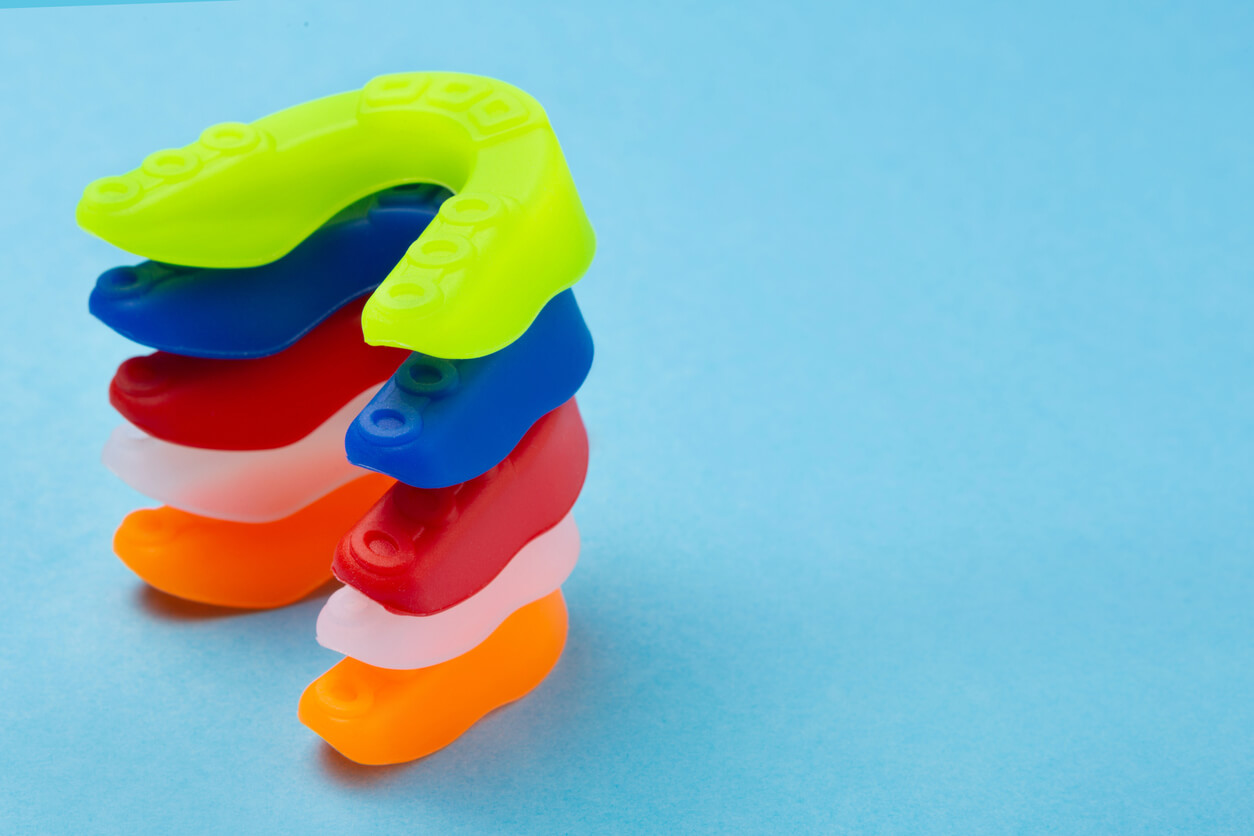Mouthguards for Children


Written and verified by the dentist Vanesa Evangelina Buffa
Taking care of children’s oral health not only involves maintaining proper hygiene and limiting the consumption of sweets. Also, the use of mouthguards is a practice that helps prevent mouth problems.
Dental trauma is a fairly common situation during childhood. In fact, it’s the second most common cause of attention in pediatric dentistry, after cavities. In this regard, games and pay can cause accidents that injure teeth. In addition, as children grow up, they begin to play sports, and the risk of blows to the mouth increases.
Mouthguards for children are a preventive measure that helps to preserve the integrity of children’s teeth and oral tissues. Find out more about these elements that make fun and safety possible.
What are mouthguards for children?
Mouthguards for children are flexible plastic appliances. In general, they cover the upper teeth which, because they protrude more in the mouth, are the most exposed to bumps and blows. However, in special cases, other designs can be used.
The main function of mouthguards in children is to cushion possible blows. This minimizes the risk of damaging or breaking teeth and injuring the lips, tongue, and other structures in the mouth. If children use fixed orthodontics, the use of mouthguards becomes essential during the practice of sports. This prevents the appliance from breaking or traumatizing the soft tissues.

Which sports are mouthguards for children recommended for?
Athletes are much more likely to suffer tooth damage if they don’t wear a mouthguard. Collision and contact sports are considered high-risk, but dental injuries can be caused by a variety of activities.
Boxing, martial arts, contact kickboxing, soccer, rugby, field hockey, gymnastics, and figure and ice skating are considered high-risk sports. On the other hand, basketball, diving, soccer, handball, parachuting, water polo, horseback riding, squash, cycling, and climbing have an intermediate risk.
What types of mouthguards for children are there?
When looking for protection for your child’s mouth, you should know that there are different alternatives. Here are the three types of mouthguards for children that you can choose from:
- Prefabricated: These are the cheapest and easiest to obtain. They come preformed in standard sizes and are ready to use, so sometimes they don’t fit or adapt very well to the mouth. Because they’re bulky, in some cases, they can be uncomfortable and make it difficult to speak and breathe.
- Semi-fitted: These mouthguards are available at some sporting goods stores and pharmacies. To use them, they’re first softened by placing them in boiling water. Then, they’re inserted into the mouth and bitten down on in order to mold them to the shape of the child’s teeth. They achieve a better fit than standard mouthguards, although the fit isn’t perfect.
- Custom-made: These devices are made to fit the child’s mouth by a pediatric dentist. For their manufacture, molds are taken from the oral cavity of the child, so they achieve an excellent fit. They’re the most expensive, but also the most comfortable and safe.

How to use mouthguards for children correctly
Mouthguards should be a piece of children’s sports equipment and should be worn at every game. Wearing them in the mouth every time a risky activity is performed decreases the chances of injury should an accident occur. At the same time, it’s important that the devices are properly cared for and cleaned. Here are some tips for their use and maintenance:
- Rinse them with water before placing them in the mouth.
- Clean them with water and a soft bristle brush after each use.
- Store them dry and transport them in a rigid, ventilated case. This prevents the proliferation of bacteria and fungi.
- Regularly check the fit of the device in the mouth. Because children are growing and their mouths change rapidly, it’s common for them to need to be replaced.
- Watch for signs of wear or breakage of the appliance, in which case it will need to be replaced.
- Bring the mouthguard to dental checkups so that the professional can check it, assess its fit, and clean it thoroughly.
- Keep the mouthguard out of the sun, hot water, and other sources of heat that can deform its shape.
Safe play with mouthguards
As parents, it’s up to us to provide safety for our little ones. In this regard, mouthguards will help you prevent injuries to your children’s mouths and take care of their teeth while they play or practice sports.
Taking care of children’s oral health not only involves maintaining proper hygiene and limiting the consumption of sweets. Also, the use of mouthguards is a practice that helps prevent mouth problems.
Dental trauma is a fairly common situation during childhood. In fact, it’s the second most common cause of attention in pediatric dentistry, after cavities. In this regard, games and pay can cause accidents that injure teeth. In addition, as children grow up, they begin to play sports, and the risk of blows to the mouth increases.
Mouthguards for children are a preventive measure that helps to preserve the integrity of children’s teeth and oral tissues. Find out more about these elements that make fun and safety possible.
What are mouthguards for children?
Mouthguards for children are flexible plastic appliances. In general, they cover the upper teeth which, because they protrude more in the mouth, are the most exposed to bumps and blows. However, in special cases, other designs can be used.
The main function of mouthguards in children is to cushion possible blows. This minimizes the risk of damaging or breaking teeth and injuring the lips, tongue, and other structures in the mouth. If children use fixed orthodontics, the use of mouthguards becomes essential during the practice of sports. This prevents the appliance from breaking or traumatizing the soft tissues.

Which sports are mouthguards for children recommended for?
Athletes are much more likely to suffer tooth damage if they don’t wear a mouthguard. Collision and contact sports are considered high-risk, but dental injuries can be caused by a variety of activities.
Boxing, martial arts, contact kickboxing, soccer, rugby, field hockey, gymnastics, and figure and ice skating are considered high-risk sports. On the other hand, basketball, diving, soccer, handball, parachuting, water polo, horseback riding, squash, cycling, and climbing have an intermediate risk.
What types of mouthguards for children are there?
When looking for protection for your child’s mouth, you should know that there are different alternatives. Here are the three types of mouthguards for children that you can choose from:
- Prefabricated: These are the cheapest and easiest to obtain. They come preformed in standard sizes and are ready to use, so sometimes they don’t fit or adapt very well to the mouth. Because they’re bulky, in some cases, they can be uncomfortable and make it difficult to speak and breathe.
- Semi-fitted: These mouthguards are available at some sporting goods stores and pharmacies. To use them, they’re first softened by placing them in boiling water. Then, they’re inserted into the mouth and bitten down on in order to mold them to the shape of the child’s teeth. They achieve a better fit than standard mouthguards, although the fit isn’t perfect.
- Custom-made: These devices are made to fit the child’s mouth by a pediatric dentist. For their manufacture, molds are taken from the oral cavity of the child, so they achieve an excellent fit. They’re the most expensive, but also the most comfortable and safe.

How to use mouthguards for children correctly
Mouthguards should be a piece of children’s sports equipment and should be worn at every game. Wearing them in the mouth every time a risky activity is performed decreases the chances of injury should an accident occur. At the same time, it’s important that the devices are properly cared for and cleaned. Here are some tips for their use and maintenance:
- Rinse them with water before placing them in the mouth.
- Clean them with water and a soft bristle brush after each use.
- Store them dry and transport them in a rigid, ventilated case. This prevents the proliferation of bacteria and fungi.
- Regularly check the fit of the device in the mouth. Because children are growing and their mouths change rapidly, it’s common for them to need to be replaced.
- Watch for signs of wear or breakage of the appliance, in which case it will need to be replaced.
- Bring the mouthguard to dental checkups so that the professional can check it, assess its fit, and clean it thoroughly.
- Keep the mouthguard out of the sun, hot water, and other sources of heat that can deform its shape.
Safe play with mouthguards
As parents, it’s up to us to provide safety for our little ones. In this regard, mouthguards will help you prevent injuries to your children’s mouths and take care of their teeth while they play or practice sports.
All cited sources were thoroughly reviewed by our team to ensure their quality, reliability, currency, and validity. The bibliography of this article was considered reliable and of academic or scientific accuracy.
- Caiazzo, A., Sanz, J. L., & Forner, L. (2020). ¿ Son efectivos los protectores bucales para la prevención de traumatismos dentales en el deporte? Una revisión sistemática. Endodoncia (Madr.), 38(3), 34-48.
- Manrique Toiran, S. (2020). Conocimiento y uso del protector bucal en deportes de riesgo en niños catalanes entre 6 y 18 años. Universitat Internacional de Catalunya.
- Valdés, L. D., & Valle-Lizama, R. L. (2021). Protectores bucales en la prevención de lesiones traumáticas dentomaxilofaciales en adolescentes durante prácticas deportivas. Revista Archivo Médico de Camagüey, 25(4).
- Solórzano Rendón, L. L. (2022). Protectores bucales en niños deportistas (Bachelor’s thesis, Universidad de Guayaquil. Facultad Piloto de Odontología).
- López Garcés, K. N. (2021). Factores predisponentes de traumatismos dentales en niños (Bachelor’s thesis, Universidad de Guayaquil. Facultad Piloto de Odontología).
- Díaz Valdés, L., Valle Lizama, R. L., & Rodríguez Ortiz, M. (2021). Nivel de información sobre protectores bucales y avulsión dentaria en entrenadores deportivos. Medisan, 25(5), 1143-1157.
- Flores, K. M. B., Molinar, Y. H., & Berber, M. Á. R. (2022, October). Uso de guardas deportivas en Odontopediatría. In XXI Congreso Latinoamericano de Odontopediatría (Vol. 12, No. Suplemento).
This text is provided for informational purposes only and does not replace consultation with a professional. If in doubt, consult your specialist.








